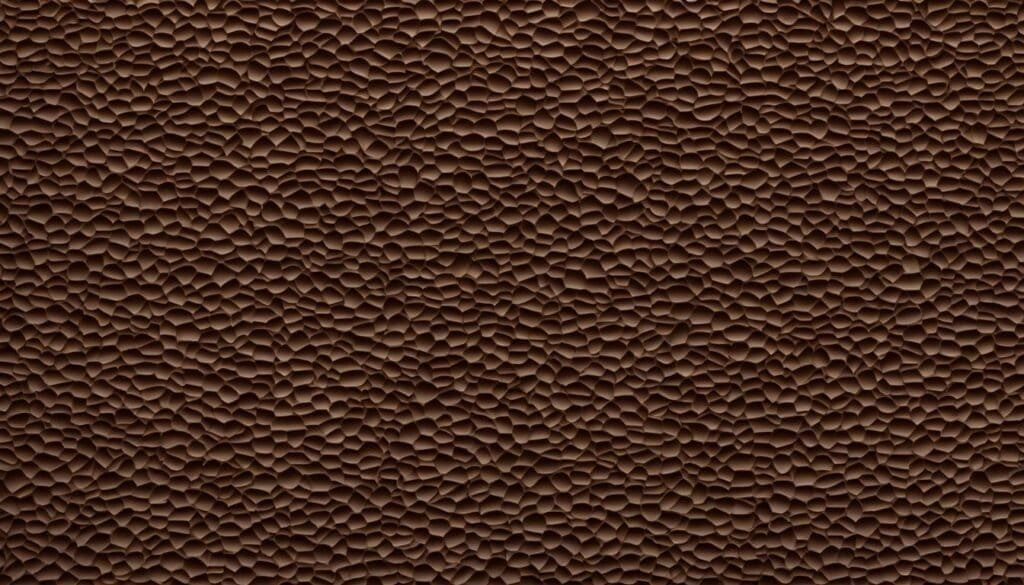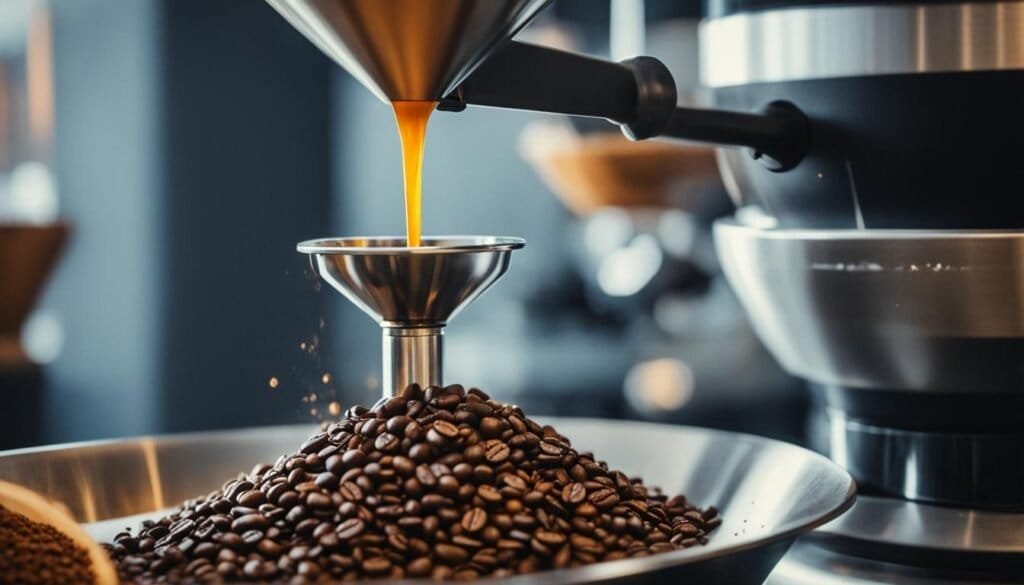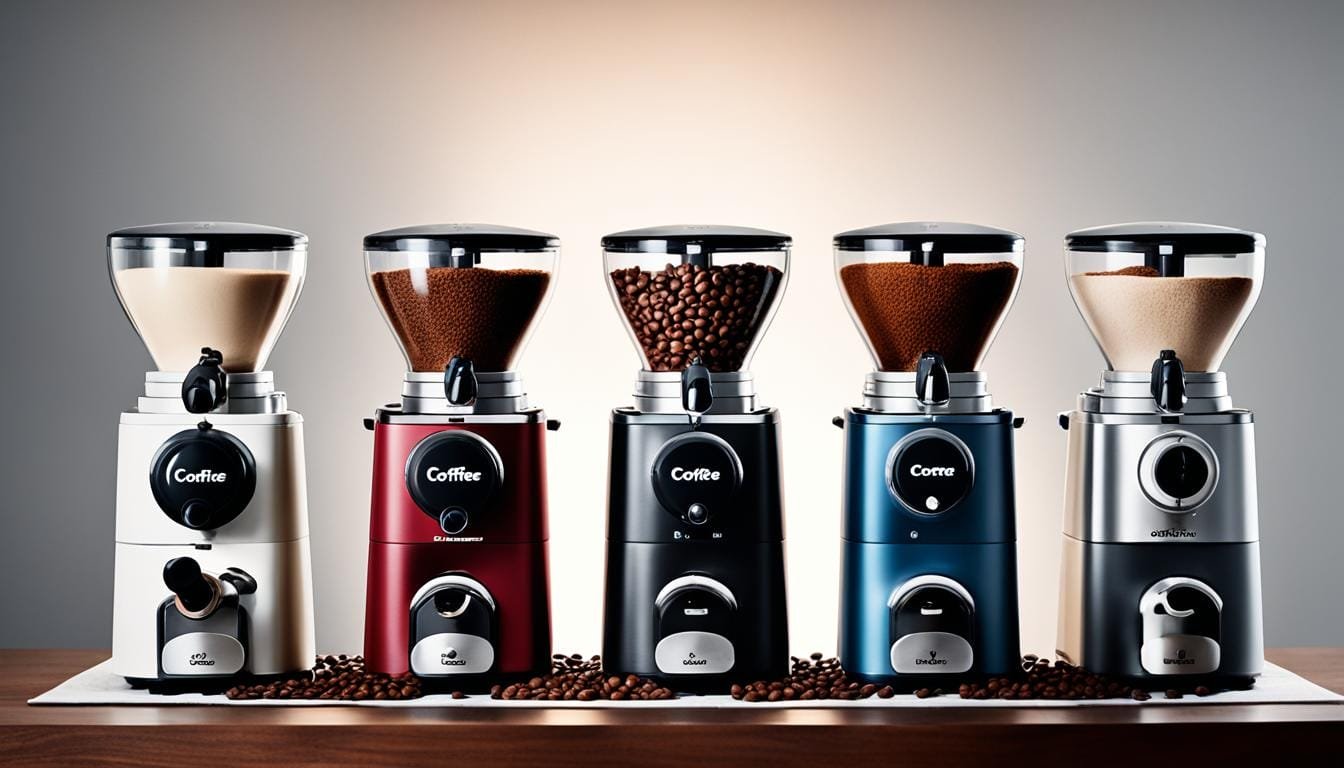Coffee enthusiasts around the world understand the importance of grinding coffee beans to achieve the perfect brew. But did you know that the grind size plays a crucial role in determining the flavor and aroma of your cup?
Whether you’re a casual coffee drinker or a devoted enthusiast, mastering the art of coffee grinding can elevate your coffee experience to new heights. From understanding the different coffee grinding techniques to choosing the best coffee grinders and exploring advanced brewing methods, there are numerous ways to enhance the flavor and quality of your coffee at home.
Key Takeaways:
- Grind size is key to extracting the desired flavors and aromas from coffee beans.
- Choosing the right grind size for different brewing methods is essential for optimal extraction.
- Investing in a high-quality coffee grinder can greatly enhance your coffee brewing experience.
- Experimenting with grind settings and techniques can help you refine your coffee flavors.
- Understanding the impact of freshness and roast profile on grind size can lead to flavorful cups of coffee.
Understanding Coffee Grinding: Size Matters
Grinding coffee is a fundamental step in the coffee brewing process. It involves breaking down coffee beans into smaller particles, allowing water to extract the flavors and aromas locked within. One crucial factor that determines the extraction process is the size of the grind.
Water extraction is influenced by the surface area of the coffee particles. Finer grind sizes expose more surface area, leading to faster extraction, while coarser grinds slow down the extraction process. The choice of grind size directly impacts the taste and strength of your coffee.
Different brewing methods require specific grind sizes to achieve optimal extraction and prevent over- or under-extraction. Let’s take a closer look at the impact of grind size on brewing and the different types of coffee grinders available.
The Impact of Grind Size on Brewing
The size of the coffee grind can greatly affect the overall brewing process. If the grind size is too fine, water may struggle to pass through the tightly packed particles, resulting in a bitter and over-extracted brew. On the other hand, if the grind size is too coarse, water may flow through too quickly, leading to a weak and under-extracted cup of coffee.
Understanding the optimal grind size for your preferred brewing method is essential for achieving the desired flavors and balance in your coffee. Let’s explore some common brewing methods and their corresponding grind sizes:
| Brewing Method | Grind Size |
|---|---|
| Espresso | Very fine |
| Pour-over (e.g., V60 or Chemex) | Medium-fine |
| French Press | Coarse |
Note: The grind sizes mentioned above are just general recommendations. It’s essential to experiment and adjust the grind size based on your personal taste preferences.
Types of Coffee Grinders
To achieve the desired grind size, coffee enthusiasts rely on various types of grinders. Let’s explore two primary types:
- Blade Grinders: Blade grinders are often more affordable and compact. They feature a spinning blade that chops the coffee beans into smaller pieces. However, these grinders tend to produce inconsistent particle sizes, resulting in uneven extraction.
- Burr Grinders: Burr grinders, on the other hand, offer more precision and control. They feature two abrasive surfaces, known as burrs, that crush the coffee beans to a consistent size. Burr grinders are available in two forms: conical burrs and flat burrs. Conical burrs are generally preferred for their ability to produce a more uniform grind, while flat burrs excel in producing even particles for espresso brewing.
Investing in a quality burr grinder can significantly enhance your coffee brewing experience, ensuring consistent grind sizes and better extraction results.
Simple Guide to Grinding Coffee
To achieve the best coffee flavor, it is important to follow a simple guide when grinding coffee. Here are the essential steps:
- Setting up Your Grinder: Start by ensuring your grinder is clean and properly calibrated. This will help maintain consistency in your grind size, which is crucial for achieving the desired flavor.
- Measuring Coffee Beans: Accurate measurements of coffee beans using a kitchen scale are essential for achieving a balanced and flavorful cup of coffee. Use the recommended coffee-to-water ratio for your chosen brewing method.
- Adjusting Grind Settings: Experiment with different grind settings on your grinder to find the perfect match for your desired brewing method. A finer grind size is typically used for espresso, while a coarser grind is suitable for French Press and pour-over methods.
- Matching Grind Size to Brewing Methods: Each brewing method requires a specific grind size to achieve optimal extraction. For a French Press, use a coarse grind. For pour-over methods, a medium grind works well. And for espresso, a fine grind is necessary.
By following these steps, you can ensure that your coffee is brewed to perfection, extracting the flavors and aromas that coffee beans have to offer.
Expert Tip:
“Experimenting with different grind settings is the key to finding your perfect cup of coffee. Start with the recommended grind size for your brewing method and adjust accordingly to achieve the desired flavor profile.”

Remember, the grind size plays a crucial role in the taste and overall quality of your coffee. Take the time to set up your grinder, measure your coffee beans accurately, and adjust the grind settings to match your brewing method. With a little practice and experimentation, you’ll be brewing a delicious cup of coffee that suits your preferences.
Exploring Advanced Grinding Techniques
When it comes to creating the perfect cup of coffee, advanced grinding techniques can make a significant difference in the taste and overall experience. In this section, we will delve into the factors that impact the grind for optimal results—freshness, roast profile, consistency, and the oxidation process.
The Freshness of Coffee Beans and Its Role in Grind Settings
The freshness of your coffee beans plays a crucial role in determining the right grind size. Freshly roasted beans release more carbon dioxide, creating a bloom and resulting in a different extraction process. As a general guideline, fresher coffee beans will require a coarser grind size, allowing for a slower extraction that brings out the desired flavors and nuances. On the other hand, older beans tend to be drier and require a finer grind setting to ensure a robust extraction.
To achieve the optimal grind size for freshness, it’s important to consider the roast profile of your beans.
The Impact of Roast Profile on Grind Size and Taste
The roast profile of your coffee beans can greatly influence the grind size needed for optimal extraction. Roasts can vary in darkness and altitude, leading to differences in bean density and moisture content. These factors affect how the coffee absorbs water during brewing.
Lighter roasts, commonly known as City Roasts, have a light brown color and retain more moisture. Due to their higher density, they require a coarser grind size to prevent over-extraction. In contrast, dark roasts, such as French Roast or Italian Roast, have a rich, dark color and a lower moisture content. These beans are less dense and need a finer grind size to maximize extraction.
Additionally, the altitude at which the coffee beans are grown can impact their density and moisture content, requiring further adjustment in grind size. For instance, high-altitude beans often have a harder cellular structure, necessitating a slightly coarser grind size to avoid over-extraction.
Consistency in Grinding: Achieving Uniform Particle Size
To ensure consistent extraction and flavor in your brewed coffee, achieving uniform particle size is key. Inconsistent grind sizes can lead to uneven extraction, resulting in an imbalanced cup of coffee. The key to achieving consistency lies in selecting the right grinder and using proper grinding techniques.
Burr grinders are recommended for achieving a consistent grind size. Unlike blade grinders that chop coffee beans into uneven particles, burr grinders crush the beans between a moving rotor and a stationary surface, creating a more consistent particle size. Choosing a grinder with conical burrs or flat burrs can further enhance the precision of your grind.
It is also important to maintain a consistent grind size throughout the brewing process. Adjusting the grind setting on your grinder based on the brewing method and monitoring the particle distribution regularly will help you achieve the desired consistency.
Understanding the Oxidation Process and Its Impact on Grind
Coffee beans undergo a process known as oxidation once they are exposed to air. As oxygen interacts with the coffee oils, flavors and aromas can degrade over time, resulting in a decrease in quality and freshness.
When grinding coffee beans, the oxidation process can affect the flavors extracted during brewing. To minimize the impact of oxidation, it is best to grind your beans just before brewing. By grinding fresh, you preserve the aromatic compounds and maximize the flavors in your cup of coffee.

In order to achieve consistency in grinding and optimize the flavors in your coffee, it is essential to consider the freshness of your beans, understand the roast profile, maintain consistent grind sizes, and minimize oxidation. By paying attention to these advanced grinding techniques, you can unlock the full potential of your coffee beans and elevate your coffee experience to new heights.
Conclusion
Mastering the art of coffee grinding is essential in elevating your coffee experience. By understanding the importance of grind size and matching it to the appropriate brewing method, you can unlock the full potential of your coffee beans. The freshness of the beans also plays a critical role in achieving optimal extraction and ensuring a flavorful cup.
Investing time in perfecting your grinding techniques will undoubtedly enhance your coffee brewing. Whether you are a casual coffee drinker or a devoted enthusiast, the journey to mastering coffee grinding is worth undertaking. Embrace the process of experimenting with different grind sizes, adjusting settings, and exploring advanced techniques to discover the perfect cup of coffee that suits your taste preferences.
Remember, fresh ground beans are the foundation of a remarkable coffee experience. They offer an explosion of flavors and aromas that pre-ground coffee simply cannot replicate. Pay attention to the grind size, as it directly impacts the extraction process and ultimately influences the taste of your brewed coffee. By prioritizing consistency, freshness, and grind size, your coffee brewing will reach new heights, delivering a satisfying and robust cup every time.
FAQ
What is coffee grinding?
Coffee grinding is the process of breaking down coffee beans into smaller particles to extract the desired flavors and aromas.
Why is grind size important in brewing coffee?
Grind size determines how quickly water extracts flavors from coffee beans. Different brewing methods require specific grind sizes for optimal extraction.
What are the approximate grind sizes for popular brewing methods?
The grind size varies for each brewing method. Some examples include coarse grind for French Press, medium grind for pour-over, and fine grind for espresso.
What types of coffee grinders are available?
There are blade grinders and burr grinders. Burr grinders can further be classified into conical burrs and flat burrs.
How should I set up my coffee grinder?
Make sure your grinder is clean and properly calibrated. Use a kitchen scale to accurately measure the coffee beans.
How do I adjust the grind settings?
Experiment with different grind settings to find the perfect match for your desired brewing method. Start with the recommended settings and make adjustments as needed.
How do I match grind size to brewing methods?
Coarser grind sizes are suitable for methods like French Press, while finer grind sizes are better for espresso machines. Pour-over methods generally require medium grind sizes.
Does the freshness of coffee beans affect the grind settings?
Yes, freshly roasted beans require different grind sizes compared to older beans. Freshness plays a crucial role in extracting the best flavors from the coffee.
Can the roast profile of the beans affect the grind size?
Yes, the darkness and altitude of the beans can affect the grind size. Lighter roasts usually require a finer grind, while darker roasts may need a coarser grind.
How do advanced grinding techniques enhance the coffee experience?
Advanced techniques consider factors like freshness, roast profile, and consistency in grinding to achieve a balanced and flavorful cup of coffee.
Why is mastering coffee grinding important?
Mastering coffee grinding allows you to unlock the robust flavors and aromas that coffee beans have to offer, ensuring an elevated coffee brewing experience.




